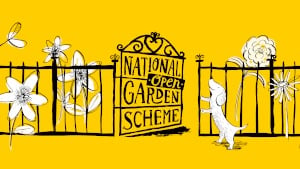About Maxstoke Castle
The Castle dates from the mid-14th century. It is built of red sandstone and includes a courtyard, encompassed by a five foot thick curtain wall, which is surrounded by a moat. The northwest part of the courtyard is occupied by an early-17th century timber-framed building. The Dilke family (latterly Fetherston-Dilke) have owned the Castle and the park of Maxstoke since 1599.
The garden is rich and varied. Apart from the larger trees, most of the planting has been carried out in recent generations.
The Approach
The Castle lies at the end of a long drive, edged with lime and horse chestnut trees, which emerges into open space and the front view the Castle, which has four octagonal towers, a gatehouse and a drawbridge.
On the left was a very old cedar of Lebanon, sadly bought down in the storms of 2021. Across the moat, the tower on the right is partly clothed with the rambling white rose ‘Albéric Barbier’. Reeds grow at the margins of the moat.
The Courtyard
The area is sometimes hot and dry in the summer, which can present challenges as there is little soil depth close to the walls.
Near the entrance are white Agapanthus in pots. Turning left is a vigorous rose ‘Frühlingsgold’, with large, pale, creamy-yellow flowers. Other plants in this area include the white shrub Exochorda x macrantha ’The Bride’, Clematis recta, Salvia patens, Penstemon, Acanthus, Delphiniums, Michaelmas daisies and Buddleia ‘Black Knight’.
The north side of the south wall is given over entirely to a low planting of Alchemilla mollis, a practical choice for a shady position but quietly ornamental.
The east side contains a densely mixed range of planting. Herbaceous plants include Hosta, Campanula, Dianthus, Salvia, Sedum, Astrantia, Euphorbia in various forms, and Geranium. Woody plants include Hydrangea ‘Annabelle’ and various roses. Fremontodendron californicum grows against the wall.
Near the entrance large pots contain Marguerite daisies trained as standards. Further on are the white-flowering Hebe Rakaiensis, different forms of Philadelphus, a Weigela and the rose ‘Macmillan Nurse’, generally making for a white theme but this may change soon as part of a replanting plan.
Adjacent to the timber-frame section of the house is a further walled area with a large fig tree in one of the corners. Here again the planting is mixed, with Tree Peonies, Salvias and Cronus kousa.
Turning back towards the entrance along the west side we find the deep blue Salvia ‘Amistad’, whose blue flowers last until November. Here too the walls have many climbing roses including arching Rosa Macrantha with long, trailing branches. Herbaceous plants include Delphinium, Echinops, Veronica, Nicotiana, Scabiosa and a red Fuchsia.
The Curtilage
There is the narrow, grassed berm immediately surrounding the Castle. On the south side, the border is fronted by the vigorous catmint Nepeta ‘Six Hills Giant’ forming a clump of aromatic, grey-green leaves. Roses here have been chosen for a palate of dark red and pink.
On the west side of the Castle the planting includes more roses, including the climbing form of ‘Claire Jacquier’, which stretches up to the battlements with small pink and yellow flowers. Flag iris makes a good show in June, albeit a brief one.
The Sunken Garden
Crossing back over the drawbridge, over the lawn there is a metal gate, against which wisteria grows freely. The Sunken Garden has quite a different feel.
Four clumps of Miscanthus grow in the corner of the Sunken Garden, with a Cedar of Lebanon in a far corner. The planting on the immediate left is mostly pink and blue, with the rose ‘Gertrude Jekyll’ prominent. Also noteworthy is the unusual Chinese rose Sericea Pteracantha, whose ostentatious thorns glow blood-red.
Moving along on the western side we meet the low-growing Pachysandra in various forms, competing in places with Salvia Yangii, previously known as Perovskia. The roses here are Rosa Mundi and more ‘Gertrude Jekyll’ and include the vigorous white ‘Sally Holmes’. The pink ‘Ballerina’. R. ‘Compassion’ grows on the wall. In the middle of the two beds is a stone seat with Deutzia Scabra Pride of Rochester on one side and Deutzia Setchuenensis on the other.
The main feature in the area is the small parterre. It consists of geometric forms of box-lined beds, with a stone sundial in the centre. At the far end, at a point where the line of the hedge is broken, is a seat, near which are Japanese cherries.
On the western side is a row of pleached Silver Limes.
Towards the wood
Leaving the Sunken Garden through a beech hedge and enter a grassy area. There are groups of low-growing roses, including the ivory-white R. ‘Jacqueline du Pré’ and on the left by the moat, ’Nozomi’, trained along a metal framework.
A path leads into the wood near the moat and then returns on the boundary side. The dominant trees along both sides are native: common alder, oak and ash. In the darker area inside the wood, we find rowan, birch, laurel and the odd rhododendron. Towards the end of the outgoing path, one emerges into a lighter area with a number of young trees, notably the golden form of the grey alder. The path returns through the wood and re-enters an open area. Here are two cedars of Lebanon, a weeping pear, a golden rain tree and a young weeping copper beech.
The Walled Garden
The Sunken Garden was originally the kitchen garden. The vegetables include asparagus, French and runner beans, cavolo nero and artichokes. The new raised beds allow for a change of soil to accommodate parsnips and carrots. The fruit cage has an abundance of gooseberries, currants, blackberries and raspberries.
On the right side of the gate, the colour palate is mainly yellow, white and blue. The vigorous Actinidia kolomikta is prominent with its pink and green variegated leaves. Also present are the rose ‘Graham Thomas’ together with Cephalaria gigantea, Astrantia and Campanula, and more Delphiniums. Lavender grows along the side of the tennis court, with R. Goldfinch and R. Raubritter on the fence. The espaliered apple at the end separates it from the kitchen garden.
Across the tennis court is a Portuguese laurel whose narrow, fragrant flower tails turn the tree creamy-white in early summer. In the bed beyond are roses of different forms including the pink ‘Marguerite Hilling’ and Kolkwitzia. Also present is the colourful Hydrangea paniculata ‘Pinky Winky’. Its star-like flowers emerge white and fade to pink, giving a two-tone effect. The layered white Cornus alternifolia ‘Argentea’ also appears.
The Swimming Pool area
The entrance to the swimming pool area is dominated by a foxglove tree, with gigantic, heart-shaped leaves. This is likely to flower and fruit more freely as the climate changes. On the same side is a hedge of Elaeagnus ebbingei– an unusual feature inspired by a French planting.
Across the pool the theme of planting is white: the well-known rose ‘Iceberg’, the whitebeam Sorbus aria, Hydrangea arborescens ‘Annabelle’, and the subshrub Romneya coulteri, with huge white single poppy flowers.
The rambling rose ‘Adélaïde d’Orléans’ scrambles over a metal arch. Beyond is a Magnolia stellata, a white buddleja and the vividly white-stemmed bramble Rubus cockburnianus. Large euphorbias also grow nearby.
Returning to the Castle past the tennis court, a number of yews have been pruned to reveal their red-brown trunks. Here we pass a magnolia, with a plaque to mark its planting. Close by is the hybrid rambling rose ‘Francis E. Lester’, whose blush pink flowers fade to white.
This is a garden born of flair and determination.
Website:
https://www.maxstokecastle.com
.jpg)
.jpg)
.jpg)
.jpg)
.jpg)
.jpg)
.jpg)
.jpg)
.jpg)
.jpg)
.jpg)
.jpg)
.jpg)
.jpg)
.jpg)
.jpg)



.jpg)
.jpg)
.jpg)
.jpg)